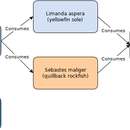en
names in breadcrumbs


Most of the several hundred fishes known as flounders are in either the Pleuronectidae (right-eyed flounders, around 100 species, many of which have a dorsal branch near the front of the lateral line that runs along the base of the dorsal fin) or the Bothidae (left-eyed flounders, which lack a dorsal branch to the lateral line, although it may be forked above the upper eye). Most pleuronectids live in temperate to cold waters; tropical species generally occur in deeper water. Pleuronectids include several commercially important species in the Arctic, Atlantic, and Pacific Oceans. These include, among others, two of the largest of all bony fishes, the large-mouthed Pacific Halibut (Hippoglossus stenolepis) and Atlantic Halibut (Hippoglossus hippoglossus), which historically grew to at least 2.5 meters and 320 kg (although as a result of intensive fishing specimens now rarely reach even half this size); the American Plaice (Hippoglossoides platessoides); flounders such as the Winter Flounder (Pseudopleuronectes americanus); and the Petrale Sole (Eopsetta jordani). A very large female halibut may be 30 years old and can produce over 2 million small eggs. Because of the eggs' neutral buoyancy, the eggs typically float in midwater, sinking gradually as development proceeds. (Eschmeyer and Herald 1983; Robins and Ray 1986; Chapleau and Amaoka 1995)
Adult pleuronectids have the eyes and color pattern on the right side of the body. Like the hatchlings of other flatfishes, at an early age pleuronectid larvae begin to lean to one side as one eye (the left eye in the case of pleuronectids) migrates across the crown to a position beside the other eye. In addition, the front of the skull twists, bringing the jaws into a sideways position, and the side of the fish that faces down when it is in a resting position turns whitish. (Chapleau and Amaoka 1995)
Pleuronectidae, also known as righteye flounders, are a family of flounders. They are called "righteye flounders" because most species lie on the sea bottom on their left sides, with both eyes on their right sides.[1] The Paralichthyidae are the opposite, with their eyes on the left side. A small number of species in Pleuronectidae can also have their eyes on the left side, notably the members of the genus Platichthys.[2][3]
Their dorsal and anal fins are long and continuous, with the dorsal fin extending forward onto the head. Females lay eggs that float in mid-water until the larvae develop, and they sink to the bottom.[4]
They are found on the bottoms of oceans around the world, with some species, such as the Atlantic halibut, Hippoglossus hippoglossus, being found down to 2,000 m (6,600 ft). The smaller species eat sea-floor invertebrates such as polychaetes and crustaceans, but the larger righteye flounders, such as H. hippoglossus, which grows up to 4.7 m (15 ft) in length,[5] feed on other fishes and cephalopods, as well.
They include many important commercially fished species, including not only the various fish called flounders, but also the European plaice, the halibuts, the lemon sole, the common dab, the Pacific Dover sole, and the flukes.
The name of the family is derived from the Greek πλευρά (pleura), meaning "rib" or "side", and νηκτόν (nekton), meaning "swimming".
The family has four subfamilies:
In some classifications, the last three subfamilies are raised to the level of families.[6][7]
Atlantic halibut, Hippoglossus hippoglossus
Greenland halibut, Reinhardtius hippoglossoides
American plaice, H. platessoides
Witch, Glyptocephalus cynoglossus
Lemon sole, Microstomus kitt
Common dab, Limanda limanda
English sole, Parophrys vetulus
Pacific sand sole, Psettichthys melanostictus
Deepwater dab, Poecilopsetta beanii
Black flounder, Rhombosolea retiaria
{{cite web}}: CS1 maint: others (link) Pleuronectidae, also known as righteye flounders, are a family of flounders. They are called "righteye flounders" because most species lie on the sea bottom on their left sides, with both eyes on their right sides. The Paralichthyidae are the opposite, with their eyes on the left side. A small number of species in Pleuronectidae can also have their eyes on the left side, notably the members of the genus Platichthys.
Their dorsal and anal fins are long and continuous, with the dorsal fin extending forward onto the head. Females lay eggs that float in mid-water until the larvae develop, and they sink to the bottom.
They are found on the bottoms of oceans around the world, with some species, such as the Atlantic halibut, Hippoglossus hippoglossus, being found down to 2,000 m (6,600 ft). The smaller species eat sea-floor invertebrates such as polychaetes and crustaceans, but the larger righteye flounders, such as H. hippoglossus, which grows up to 4.7 m (15 ft) in length, feed on other fishes and cephalopods, as well.
They include many important commercially fished species, including not only the various fish called flounders, but also the European plaice, the halibuts, the lemon sole, the common dab, the Pacific Dover sole, and the flukes.
The name of the family is derived from the Greek πλευρά (pleura), meaning "rib" or "side", and νηκτόν (nekton), meaning "swimming".